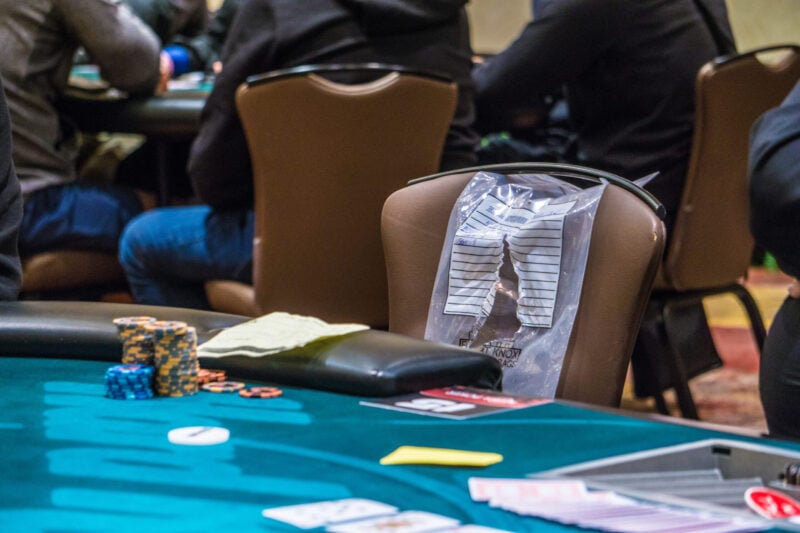In my previous article, I posited that using game theory in live, low-stakes cash games is foolish. By this I meant, we should nearly always make exploitative rather than GTO decisions when playing against weak players. Nevertheless, understanding general game theory concepts can be useful at times.

“’Tis better to have loved and lost than never to have loved at all. In other words, love is a dominant strategy.”
— Avinash K. Dixit
We know that most NLH situations are extremely complex and can only be solved by simplifying our modeling assumptions. So let’s analyze a relatively simple cash game situation that can be solved.
Heads-Up River Example
In this hand, Hero has A♦Q♦ on the button in a Vegas $1/$2 NL cash game. Two players limp, Hero raises to $15, and one of the limpers calls. Hero 3-bets his top-pair on the Q♥J♦7♥ flop and gets a call. Hero also bets the 2♦ turn, and gets called again. Both players now have $100 remaining with $200 in the pot.
The river is the 5♥ and the villain shoves, representing a flush.
Let’s assume that the villain’s range is polarized: he has the nuts or he has air. Even if the villain also shoves a small flush, a set, or two pair, Hero’s hand is now just a bluff catcher. In the absence of a tell or other special knowledge about the villain, what should Hero do?
Curious Case of the Half-Pot Shove
The GTO solution here depends on the relative size of the shove. Let’s define P as:
P = (Pot Size) / (Shove Size)
In this case, P = $200/$100 = 2. I discuss the math of this analysis in Chapter 7.4 of Tournament Poker for the Rest of Us, but we can make a couple of general statements when the villain shoves:
- A shove for more than half-pot can never be a GTO shove, regardless of whether the villain has the nuts or air. So, a shove for more than $100 would indicate he is not playing a GTO strategy. In that case, we should respond according to our estimate of his shoving range and our pot odds.
- When the villain shoves for less than a half-pot ($100), he should shove all of his nut flushes and bluff-shove a fraction of hands equal to 1/(P+1) of his flushes. In other words, 1/(P+2) of his shoves should be bluffs.
Suppose 30 percent of villain’s river hands are nut flushes. For the case of a half-pot shove, GTO strategy mandates that he should shove all of these flushes, plus another 10 percent of his river hands, so that 3/4 of his shoves are flushes. Consequently, the villain should shove 40 percent of his river hands and check the other 60 percent.
Based on these estimates, when the villain does shove, Hero should call with his own nut flushes and (P-1)/(P+1) of his bluff catchers. For the half-pot shove in this case, Hero should call with 1/3 of his bluff catchers. (Perhaps he looks at the second hand on his watch to decide.)
This is not the same as calling 1/3 of his river hands.
Toy Game Examples
Although this seems to be a GTO model of a real cash game, it is not. We have made several assumptions with restricted rules that make it a Toy Game:
- We assumed both players are playing a GTO strategy. This is rarely the case in a real game. In fact, if the villain shoves more than half-pot, we know he is not playing GTO. Normally, we should just assume he is not playing GTO, and respond exploitatively to his shove.
- We assumed the villain can only check or shove. In a real game, the stacks can be such that many other bet sizes are reasonable. For example, if the villain bets half-pot with money behind, our GTO analysis is no longer correct.
- We assumed that the villain has the nuts or air. This analysis is much murkier when the villain has a strong, but non-nut hand. For example, suppose the villain has a small flush and so does Hero. (Is Hero’s hand a bluff catcher?) Or perhaps the villain has two-pair and Hero has a set or two-pair? The standard Toy Game GTO analysis sweeps these possibilities under the rug. The question of what constitutes the “nuts” and what constitutes a “bluff catcher” complicates the analysis considerably.
On The Knife’s Edge
Clearly it’s difficult to estimate how many flushes the villain should have by the river, especially when flushes might include non-nut hands he feels are best. Indeed, most of us will not know what our own river “nuts percentage” would be in a particular hand. This makes proper GTO river shoves and calls extremely difficult to make in real time.
All is not lost, however. Rarely does an opponent make a proper GTO shove, so we only need to determine whether our villain tends to bluff-shove too often or not often enough, relative to the proper GTO percentage.
Suppose a villain never shoves without the nuts (he never bluffs). Our exploitative response to his non-GTO strategy is to never call with our bluff-catcher since we would always lose. Interestingly, this response is correct even if the villain only under-bluffs by a small amount; we would then win some and lose some, but we would have a net positive expectation if we always folded.
In the absence of a read, our exploitative response turns out to be simple:
- Always fold to a villain who bluffs less often than GTO.
- Never fold to a villain who bluffs more often than GTO.
Since the vast majority of low-stakes cash game players don’t make big river bluffs, our default response to an unknown villain should be to fold our bluff catchers. Nevertheless, we still have the problem of how to define “bluff catcher”.
When we can identify a specific player as very aggressive and bluff-happy, our response might be to call with these same bluff catchers. The skill here is not our immense GTO knowledge, but our ability to read our opponents. We are using our GTO knowledge exploitatively.
(Note: Don’t show your folded bluff catcher. An observant opponent might exploit you.)
Conclusion
It is very difficult to use precise GTO strategies in low-stakes cash games, but this is actually unnecessary since such a strategy is designed to make us unexploitable against the rare GTO villain.
We are much better off using our poker study time learning other skills that allow us to exploit the weak players in these games. Yet, there are a few situations that allow us to use our GTO knowledge exploitatively, such as the example described here.
Steve Selbrede is a retired Silicon Valley engineer living in Las Vegas. He is the author of six poker books, including his most recent Tournament Poker for the Rest of Us (presented by CardsChat).


